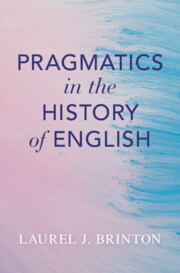Book contents
- Pragmatics in the History of English
- Pragmatics in the History of English
- Copyright page
- Contents
- Figures
- Tables
- Preface
- Abbreviations
- 1 The Field of Historical Pragmatics
- 2 Historical Pragmatics
- 3 Pragmatic Markers
- 4 Speech Representation
- 5 Politeness
- 6 Speech Acts
- 7 Address Terms
- 8 Discourse: Register, Genre, and Style
- 9 Concluding Remarks
- References
- Index
8 - Discourse: Register, Genre, and Style
Published online by Cambridge University Press: 28 September 2023
- Pragmatics in the History of English
- Pragmatics in the History of English
- Copyright page
- Contents
- Figures
- Tables
- Preface
- Abbreviations
- 1 The Field of Historical Pragmatics
- 2 Historical Pragmatics
- 3 Pragmatic Markers
- 4 Speech Representation
- 5 Politeness
- 6 Speech Acts
- 7 Address Terms
- 8 Discourse: Register, Genre, and Style
- 9 Concluding Remarks
- References
- Index
Summary
Chapter 8 provides a select introduction to register, genre, and style. The multidimensional analysis of style reveals a gradual drift from “literate” to “oral” over time. Attention is given here to the news and religious registers. The news register has seen the rise of the newspaper, leading to the introduction of new publication types, such as television, radio, and internet news, and new genres, such as editorials, obituaries, or weather forecasts. The religious register has a long history and has been remarkably stable. Two religious genres, prayers and sermons, have changed little in respect to function, structure, and linguistic characteristics. The function of recipes remains constant (i.e., instructions on how to prepare or do something), thus accounting for the imperative as the defining linguistic form, but we find differences in the content of recipes (medicinal vs. culinary), in the audience of recipes (e.g., the professional vs. the amateur cook), in the structural elements found in recipes (e.g., separation of the ingredients and the procedural steps), and in characteristic linguistic features (e.g., the introduction of null objects and telegraphic style).
Information
- Type
- Chapter
- Information
- Pragmatics in the History of English , pp. 185 - 214Publisher: Cambridge University PressPrint publication year: 2023
